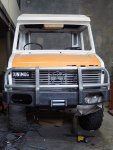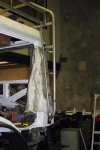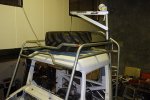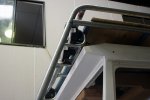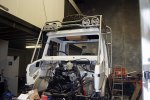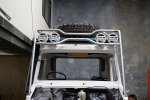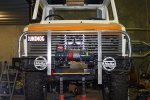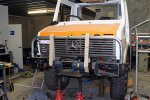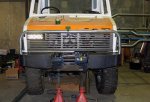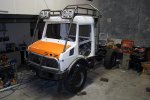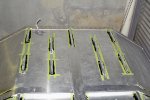I have not done as much work as I wanted the last few weeks - first off I have been away "Consulting the Community" at work - and I also got the flu - not pleasant at all. We also had a photo shoot for 4WD Action magazine of the Discovery, which meant I had to spend some time cleaning and polishing it - the photo shoot was great fun, it took the whole day and by the end the Discovery was muddy again.
The lining panels have started to arrive.

They are very light, made from two sheets of 1.8mm plywood and 6mm of foam, but the are very strong. They will be covered in 0.8mm of white Formica, so that will make them very tough and hard wearing. Once all the panels are here, I will mark all the areas for inspection opening and wiring openings - then send them back for finishing. Next time I see them it will be to fit them in their final position.

Back to the Bullbar fabrication:
The infill panel arrived, and I can finally weld the thing up. Lots of clamps etc, but the temporary braces worked well, and the section fits in perfectly. I have to fabricate the supports as well - all from 6mm plate. The bolts are all M16, and after I tack the support in place I discovered that the rear bolts were too long to get out to the hole - so I have to cut a slot in the rear bolt hole to get them in and out.

Next is to cut the various slots for the winch cable, the handle for the clutch and a slot to see how the cable winds up on the drum. I also mounted the roller fairlead. The main beam Hella 4000's fit in quite nicely.

I'm getting used to making cardboard templates - its a great way to see how things will look without too much effort. I tried a few different styles of support for the bar work, and this is what I think looks the best.
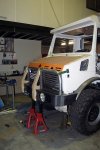
I have to make the front supports deep enough so that the fairlead does not protrude past - one of the ADR requirements. Not sure how getting hit with a fairlead or a solid steel bumper would made a difference, but apparently it does.
Now to turn cardboard into steel

I made the first support out of 6mm plate, but ran out and had to get some more the next day. That's the man problem working at night, if you run out of something, then it's either take time of work or wait until the weekend, luckily the steel supplier is just around the corner and opens at 7:00am, so I was able to get some the next day. I made them exactly the same by cutting the second one roughly, then tack welding the two plates together, and finishing off all the edges with a grinder. I welded these in place on late on Friday night.
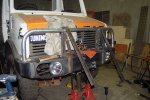
Next step was the flat bars to brace the supports. I welded them on starting with the bottom at the back - that way I was able to bend them a lot by hand.
I started again on Saturday morning, this time armed with a propane torch and a big hammer. After much heating hammering and tacking, I had the supports in place - I only had to cut one of the tacks off to realign the strips - must be getting better at this fabrication business.
Next was to weld it all up - there is lots of welding, and as the plate is all 6mm, that means turning up the welder to the max. It generates a lot of radiant heat - there were time when I could see the smoke starting to come off the welding gloves before I feel the heat starting to come through the gloves - then I had to stop or risk melting my fingers.
This is what it looked like after much welding:

The next stage was the lower bar - I didn't want the space between the bumper and the upper bar to be too big - else the pesky kangaroos might find a way to commit suicide by jumping into the radiator.
After even more bending, cutting and welding
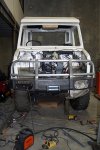
And this is how I left it this evening - as with all things I do, it's not perfect, the welding pulled the whole thing skew by about 3mm - but I doubt most people will notice. The bar is pretty heavy, I can lift it off, but it is just too heavy and a difficult shape for me to lift it back on by myself - that's where my trusty forklift comes into place. I think it weighs around 60kg - but I'll borrow the scale tomorrow and weigh it.
